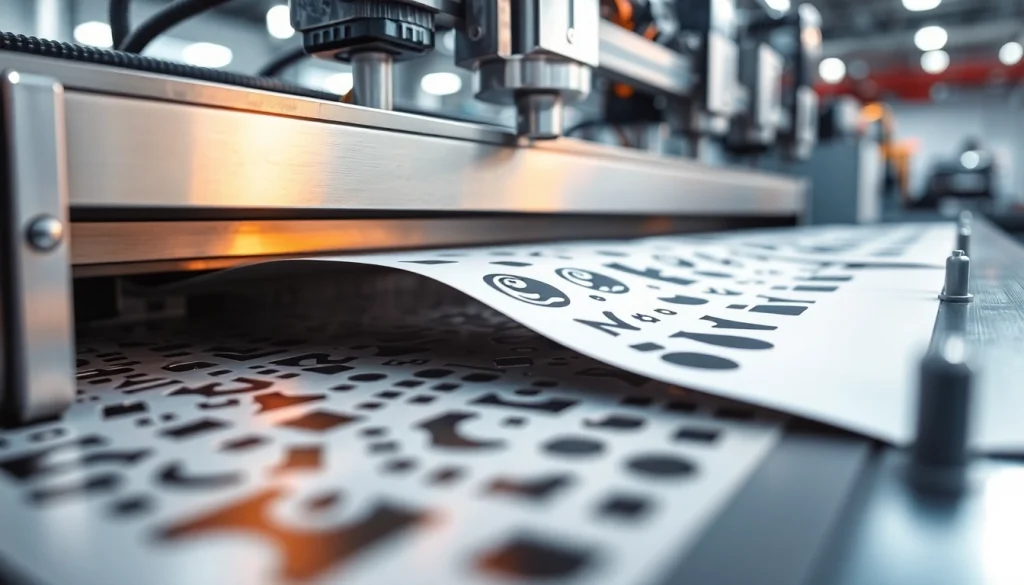Understanding Precision Die Cutting
Precision die cutting is a vital manufacturing process employed across various industries, including automotive, medical, packaging, and electronics. This method produces highly accurate and consistent shapes from a multitude of materials, such as rubber, plastics, paper, and fabrics. Unlike conventional cutting techniques, precision die cutting utilizes pre-shaped dies to ensure that each cut matches exact specifications. With the ability to create complex shapes quickly and efficiently, precision die cutting has revolutionized the way products are manufactured.
What is Precision Die Cutting?
At its core, precision die cutting is a manufacturing process that involves the use of specialized tools known as dies to cut materials into specific shapes. These dies can be made from various materials, including steel or brass, depending on the application requirements and material thickness. The process is typically performed using machines that exert immense pressure, allowing the die to cut through the material cleanly. Precision die cutting can be applied to different types of production runs, ranging from small to large scale, making it a versatile option for manufacturers.
Benefits of Precision Die Cutting in Manufacturing
The adoption of precision die cutting brings numerous advantages to manufacturing processes, including:
- High Accuracy: This method ensures that each cut is exactly as specified, minimizing material waste and ensuring product consistency.
- Speed: Automated die cutting machines operate at high speeds, significantly reducing production times compared to manual cutting methods.
- Cost-Effectiveness: For large volumes, the overall cost per unit decreases, making it a financially viable option for manufacturers.
- Versatility: Precision die cutting can be utilized across a wide range of materials, allowing manufacturers to create diverse products.
- Complex Shapes: The ability to create intricate designs that might be difficult to achieve with other cutting methods.
Common Applications of Precision Die Cutting
Precision die cutting finds applications in numerous sectors, including:
- Automotive Industry: Often used for gaskets, seals, and insulation.
- Electronics: Typically utilized for producing components such as circuit boards or insulation materials.
- Medical Devices: Used for creating parts that require stringent regulatory compliance and precision, such as surgical instruments or bandages.
- Packaging: Employed to produce customized packaging solutions that enhance product safety and presentation.
Types of Precision Die Cutting Techniques
Flatbed Die Cutting Explained
Flatbed die cutting involves the use of a flatbed press that applies pressure to cut material using a flat die. This technique is particularly effective for medium to large runs and is notable for its flexibility in handling diverse materials. Flatbed die cutting is ideal for intricate designs, offering high levels of precision and excellent product quality. It is widely used in the production of packaging, signage, and other custom applications.
Rotary Die Cutting: Pros and Cons
Rotary die cutting utilizes a cylindrical die that spins to cut the material as it moves through the machine. This method is advantageous for high-volume jobs, delivering quick turnaround times and offering superior consistency. Pros of rotary die cutting include:
- High efficiency for long production runs
- Lower operational costs for mass-produced items
However, rotary die cutting can have drawbacks, such as:
- Higher initial setup costs for custom dies
- Limited ability to handle thicker materials depending on the machine’s capacity
Laser Die Cutting Technologies
Laser die cutting employs focused laser beams to cut materials with extreme precision. This technology is ideal for intricate designs and can quickly accommodate changes in design without the need for new physical dies. Laser cutters are especially effective for materials that are difficult to die cut using traditional methods, such as delicate fabrics or thin films. However, laser cutting can sometimes be slower than other methods for high-volume production.
Choosing the Right Die Cutting Service
Factors to Consider When Selecting a Die Cutting Partner
Choosing the right die cutting service is crucial for ensuring that your projects are completed to the highest standards. Factors to consider include:
- Reputation: Look for a provider with a solid industry reputation and positive customer reviews.
- Experience: Evaluate the company’s experience in handling projects similar to yours.
- Capabilities: Consider whether the service provider offers the specific die cutting techniques you require.
- Customer Service: Gauge their responsiveness and willingness to address your needs throughout the project.
Evaluating Quality and Turnaround Time
Quality assurance is paramount in precision die cutting. When evaluating potential service providers, inquire about their quality control processes and certifications. Additionally, turnaround time can significantly impact your production schedule. Assess their average lead times and compare them with your project timelines to ensure alignment.
Cost Considerations in Precision Die Cutting
The cost of precision die cutting can vary widely based on factors such as material, design complexity, and production volume. It is essential to obtain detailed quotes from different providers and consider not just the price, but also the value offered in terms of quality and service. Many companies provide a price breakdown that highlights tooling, setup, and per-unit costs, allowing you to make informed decisions based on your budget.
Best Practices for Precision Die Cutting Projects
Design Considerations for Optimal Results
To achieve optimal results in precision die cutting, carefully consider your design specifications. Utilize CAD software to create detailed design files that can be accurately replicated by the die cutting machine. Ensure that you account for material thickness, tool wear, and potential design modifications during the design phase. Ideally, collaborate with your die cutting partner early in the design process to integrate their expertise and technologies.
Material Selection for Precision Die Cutting
The choice of material can significantly impact the effectiveness of the die cutting process. Consider factors such as material thickness, durability, and compatibility with the die cutting technology you intend to use. Common materials include:
- Cardboard and Paper
- Foam and Rubber
- Plastics
- Metal Sheets
Always request material samples and test cuts from your provider to ensure compatibility before commencing full-scale production.
Post-Processing Options After Die Cutting
Post-processing refers to additional operations performed on the cut parts after the die cutting process. This may include laminating, sewing, or coating to enhance the performance and aesthetics of the final products. Identify these requirements early and communicate them to your die cutting service provider to ensure that they can accommodate your needs.
Future Trends in Precision Die Cutting
Technological Innovations in Die Cutting
The future of precision die cutting is set to be shaped by technological advancements, including the integration of artificial intelligence (AI) and machine learning into design and production processes. These innovations may enhance production efficiency, allow for real-time adjustments based on material performance, and improve the overall quality of die-cut products.
Sustainability Practices in Precision Manufacturing
As industries increasingly prioritize sustainability, precision die cutting is evolving to incorporate eco-friendly practices. This includes using recyclable materials, optimizing cutting processes to minimize waste, and ensuring energy efficiency in production. Manufacturers who adopt sustainable practices can enhance their market appeal and comply with growing regulatory requirements.
The Impact of Automation on Die Cutting Efficiency
Automation technologies are expected to play a significant role in refining precision die cutting processes. Automated systems can significantly boost production speed and accuracy, reduce labor costs, and enhance safety for operators. As automation becomes more prevalent, businesses that embrace this trend are likely to dominate the market due to improved efficiency and reduced operational expenses.



